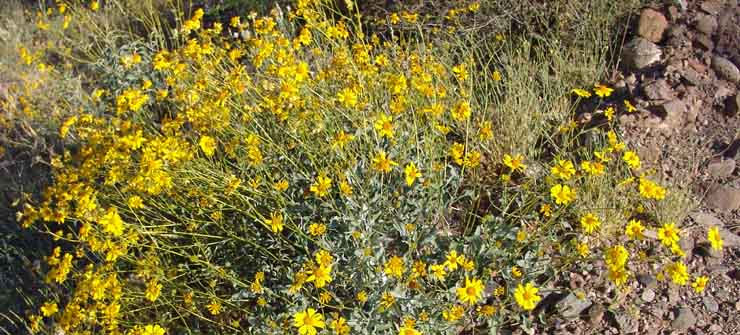Brittlebush (Encelia farinosa)
Family Asteraceae
A member of the Sunflower family, Brittlebush is one of the defining shrubs of our Arizona Uplands (Sonoran Desert), but reaches its upper elevational limits in our area. It is said (By Epple, main Wildflower page, p. 270) to be found mainly 3,000 feet elevation, but in April of 2005 we saw it while driving down the Redington Road from Tucson, descending toward the San Pedro River Valley, blooming profusely, a ways before we encountered Palo Verde trees and then Saguaro cacti even further below. As Janice Bowers (cited on Wildflowers page) puts it, brittlebush at its best forms a neat hemisphere of blue-green leaves, while at its worst it becomes "a collection of white stems to which a few withered, gray leaves cling...." (p. 96) The plants reach a height of about 3 feet in some areas, but they are smaller in our area. Here, below, you see three of these brittlebush plants, leafing out anew after the monsoons of July & August 2004:

The old withered leaves are quickly replaced by an entire new canopy, as shown at left. Click on the image to enlarge it. This is a late-leafing set, growing up after October rains in 2003. The old, dead flower stalks may be seen rising above the new growth.
Brittlebush flowers are "bright yellow daisylike rays and disks; to 2" wide in branched clusters; on tall, brittle stems forming a yellow canopy above foliage" (Epple, cited on Wildflowers page, p. 270), and Bowers (op.cit.) reports that the blossoms may reach the size of a half-dollar; the leaves are "greenish gray to silvery gray and woolly; oval, oblong or triangular-shaped; to 4" long" (ibid.);
this set below was completing its blooming in April of 2005 after late Winter rains;

If you compare this image just shown with the one at the top of the page, you will see two plants at different stages of blooming (though the photos were taken on the same day). Note the differing mix of the darker gold and the yellow, more striking in this photo than the one at the top. But what is distinctive about both of these examples is that, in strong sunlight, Brittlebush display can become visually so "hot" it is almost painful to the eyes. Wondering how the insects respond to such light, we looked more closely at the flowers. Sure enough, we saw a Hover Fly on one of them, but as we looked closer we saw it seemed to have a golden bulb attached to its body. Moving closer, we saw the golden bulb reveal itself as a small spider, which quickly took flight with its prey down its line of silk to a stem, where it sought to hide from us behind a leaf. Click on each image to enlarge it.
 .......
.......
The image at the right shows that the spider has already sucked the Hover Fly's abdomen dry. Note how, in both images but especially the one on the right, you can see that the spider is two-toned, the abdomen a darker gold than the thorax and arms, a pattern which closely matches the contrastive golds of the flower. See also Spiders for more on this subject.
After all their high-energy blooming, Brittlebushes typically show signs of withering: here are plants photographed two weeks later:

As Kearney & Peebles (cited on Wildflowers page, p. 904) put it, "the [Brittlebush] stems exude a gum that was chewed by the Indians and also was used as incense in the churches of Baja California. The leaves contain an organic compound that is toxic to other plants...."

